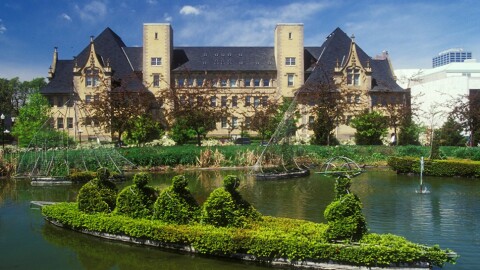Heading east towards Columbus on I-70, many observant drivers spot one of Columbus’ strangest landmarks just across the Scioto River—three enormous concrete pillars sticking out of the ground near a power substation. Visitors to Scioto Audubon Metro Park may also have noticed the three giants behind a chainlink fence at the northern edge of the park.
Curious Cbus has received more questions about these mysterious monoliths than anything else in the city, and it’s taken a while to fully unearth their story.
The pillars are part of an art installation called “Needles of Stone” that was created in 1989 to beautify the land surrounding the newly-built Furnace Street electrical substation. A team of three Ohio State University Landscape Architecture students collaborated with a group of engineers from the Columbus Division of Power to design and build the 16-foot monoliths.
According to a brochure from the substation’s grand opening, the installation takes inspiration from ancient beliefs about energy, including “a school of thought that the earth radiates energy to which prehistoric people were sensitive.”

In the mid-1800s, this alleged sensitivity was a leading explanation for the prevalence of ancient megaliths, such as Stonehenge and Easter Island. By placing stones in certain locations, it was thought that ancient peoples could harness energy from deep inside the earth.
“These ‘Needles of Stone’ were placed at this substation to symbolize the focusing of modern energy to the people of Columbus just as earlier people may have focused energy for their purposes,” the substation’s brochure explains.
One of the students behind the installation was Ken Dickerman, a 1989 Ohio State University graduate who studied Landscape Architecture. He helped design the pillars with fellow Landscape Architecture student Damon Wilson for a class project. Their assignment was to revitalize an area of industrial decay on Whittier Street, which would become Scioto Audubon Metro Park two decades later.
“Damon and I met with the project manager, and he said he was open to doing something that was unique and visual,” Dickerman told �ǿ�����ý in an email. After tossing around several ideas related to ancient cultures and landscapes, the students decided to focus on Stonehenge. “This developed into the idea of monoliths arranged as if a powerful spiritual place to gather.”

Very few records of the installation’s design and construction are available 30 years later. Although the lack of public information about the installation give the "Needles of Stone" an air of mystery, Dickerman's account of why and how these pillars were built is more practical than anything else.
“The budget was limited, [which] is probably why there were only three and in the form of a triangle,” he explained. He also attributed the piece’s emphasis on ancient spirituality to the circumstances. “At the time we were probably studying ancient cultures and landscapes.”
Whether you see these monuments as a powerful tribute to ancient cultures or just an odd public art project, Columbus’s own Stonehenge has turned something as mundane as a power substation into the area’s most asked-about mystery.



